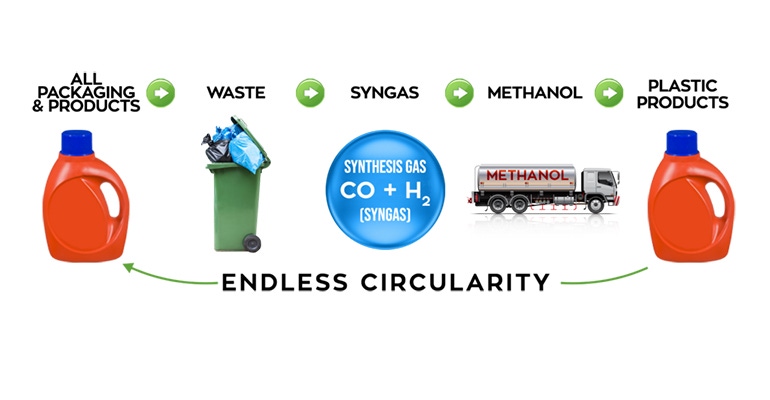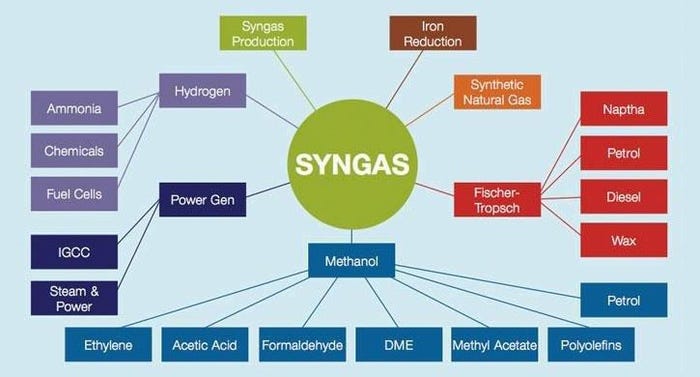Here’s why syngas production is a better choice than Extended Producer Responsibility, which has shown negative effects without positive results.
April 14, 2021

Robust advanced conversion of waste to syngas is happening. Short for synthesis gas, syngas is useful for producing clean power, hydrogen, liquid fuels, and feedstock chemicals for producing products and packaging. Briefly, syngas is primarily a mixture of carbon monoxide (CO) and hydrogen (H2) and is produced through gasification of carbon-based materials such as wood, biomass, coal, plastics, and a variety of items found in municipal solid waste (MSW).
Since every commercial use for syngas requires specific infrastructure, it is up to each consuming industry to stake a claim for the “recycled content” created when syngas is produced from waste. The airline industry was quick to claim the benefits of waste-derived syngas. Massive facilities are being erected in the US, Canada, and UK to supply waste-derived jet fuel. United Airlines recently announced its “Eco-Skies” initiative commitment to using “sustainable fuel made from renewable resources and waste byproducts” (Note: the sustainable fuel United Airlines is sourcing is made from waste derived syngas through subsequent Fischer-Tropsch chemistry).
Syngas is rich in hydrogen gas and is therefore demanded by industries committed to the hydrogen economy. Toyota, Amazon, British Airways and many others are turning to hydrogen and fuel cell technologies as an alternative to battery storage. Waste derived syngas is becoming a major source of hydrogen for these markets.
Eastman Chemical’s example.
The airline industry may seek out facilities dedicated to conversion of biomass to so that resulting fuel qualifies as “bio-fuel.” Demand for jet fuel from each biomass to Syngas/Fischer-Tropsch installation will likely exceed supply for the foreseeable future, so the packaging industry should not expect to source “recycled content” from facilities designed to serve aviation.
Noticeably absent is the group of industries that serve the consumer-packaged goods (CPG) markets. These include brand owning CPGs, packaging converters, and raw material suppliers. One exception is Eastman Chemical, which has been producing syngas from coal for many years in Tennessee, but is working to convert its coal fired gasifier to run on waste plastics. Eastman is also making major investments in chemical depolymerization of polyester. Estee Lauder and Eastman recently announced a memorandum of understanding for supply of “waste-derived recycled content”, which bodes well for the packaging industry.
However, the industry is going to need much more supply than Eastman will be able to provide. Also, reverse logistics economics and environmental sustainability objectives dictate that investments in robust waste-to-syngas facilities are required at locations where waste is currently concentrated.
The Consortium for Waste to Syngas Circularity was recently formed as a grass-roots movement by a group of packaging related companies to solve some of the most intractable problems with waste collection, sorting and recycling and to help to focus the packaging industry’s attention on the promise and opportunity to achieve true circular economy sustainability via waste conversion to synthesis gas. The vision of the Consortium states, “We envision a world without waste, in which waste is treated as a valuable resource. We seek to end the practice of landfilling and incineration, favoring processes that support circular economy sustainability. We envision a world where molecules derived from nature’s precious resources can be used and reused in an endless loop of circularity. We believe that Advanced Recycling technologies, such as such as robust waste-to-syngas, offer opportunities to solve intractable recycling challenges posed by modern multi-layered, multi-material products and packaging. The Consortium for Waste to Syngas Circularity (CWSC) promotes investment in robust and flexible waste conversion infrastructure through advocacy, education, research and outreach.
The Global Syngas Technology Council (GSTC) is another entity with an interest in syngas. GTSC’s stated mission is to promote, “the role that syngas technologies play in helping improve the energy, power, chemical, refining, fuel and waste management industries. GSTC encourages the use of economically competitive and environmentally conscious technologies to produce electricity, fuels, chemicals, fertilizers, substitute natural gas, and hydrogen from a variety of feedstocks, including coal, petroleum coke, natural gas, refinery liquids, biomass and waste” (GTSC, 2021).

While Figure 2 (above) shows the remarkable flexibility of syngas, each application requires specific investments and considerations. To maximize benefits from waste derived syngas, the packaging industry must support investment in “robust” waste conversion infrastructure. Robust processes are capable of accepting complex mixed waste including multi-layer, foil laminated Tetra Pak juice boxes, in-tact spent Keurig K-cups complete with polymer coated foil, moist coffee grounds, filter paper and plastic cup (whether polystyrene or polypropylene),Crest and Colgate multi-layer toothpaste tubes, Nestle, Coca Cola and Pepsi bottles with difficult to remove labels, adhesives and decorative shrink films, Campbell’s Soup Soup-at-Hand packages with No. 7 plastics with attached metal pull-top ends, Frito-Lay metallized, multilayer chip bags, Wrigley gum wrappers and even Mars biodegradable Skittles packs. With robust waste conversion technologies, the many packages that we normally deem to be “not-recyclable” are readily converted to syngas, methanol and back into virgin quality plastics for packaging.
Syngas itself is not easily transported so it must be converted into an easily transportable form. The simplest is methanol. Fortunately, methanol is an ideal primary feedstock chemical for many products, especially plastics used for packaging. Anyone interested in circular economy sustainability must appreciate the potential for “recycled content methanol” to fundamentally transform sustainable manufacturing. Waste-derived syngas is the key to this transformation. Recycled content methanol is a fungible, transportable and flexible primary feedstock chemical from which many circular, recycled content products will be manufactured. While chemically identical to traditional methanol. Waste derived methanol carries the added “recycled content” value that is growing in demand by all brand owning CPGs who are pledging to increase recycled content in their products and packaging. The chemical and plastics industries will be able to source primary feedstocks blended to specific amounts of recycled content, up to 100%, with the same quality as traditional virgin materials produced from fossil fuels.
What the packaging industry must do.
The packaging industry must comprehend the robust, flexible, and truly circular nature of this approach to achieving sustainable materials for products and packaging. The packaging industry must communicate and demonstrate demand for products produced from “recycled content primary chemicals” sourced from waste-derived syngas. The most powerful demand signals are through contracts with suppliers. Even in absence of current supply, CPGs can contract for future supply so that the necessary policies and infrastructure investments can be made to supply predictable demand. The Consortium for Waste to Syngas Circularity is focused on promoting investment in robust waste to syngas infrastructure. Every company associated with the packaging industry should consider adding its voice to this consortium of like-minded companies.
One of the main reasons China stopped accepting the world’s plastic waste is that China didn’t need it anymore. China invested to commercialize the methanol to plastics reactions discovered by Mobil in 1977 (“Mechanistic investigations of the methanol-to-olefin (MTO) process on acidic zeolite catalysts by in situ solid-state NMR spectroscopy”, Wang W, Jiang Y, Hunger M, Catalysis Today 113(1-2):102-114, 2006).
Wang, 2006). Research at China’s Dalian Institute of Chemical Physics led to China’s first demonstration plant in 2006, commercialization by 2010 and by 2016 China had 13 plants consuming more than 18 million tons annually of methanol derived from syngas made from China’s domestic supplies of coal (Xin, 2016). By 2019, China’s methanol to plastics processes accounted for about 21% of China’s domestic ethylene capacity. China’s successful commercialization of methanol to plastics technology provides confidence in the viability of the robust waste-to-syngas-to-methanol-to-plastics vision. Syngas is not a silver bullet, but it is the key to circular economy sustainability for industries involved in consumer-packaged goods. The technology to robustly convert waste to syngas exists today but is ripe for investment, iteration, scale-up and optimization. EPR is no substitute for innovation. The packaging industry should focus its resources on innovative technologies that solve the problems that are the cause of public frustration over packaging and plastics. Robust waste to syngas technology promises to simplify waste collection and sorting, improve traditional recycling, reduce the need for landfilling and incineration and create a true circular economy for plastics, packaging, and other waste. With waste handling solved, the packaging industry can focus its attention on mitigating the scourge of litter. Additionally, given the long-term promise of waste-derived syngas, the packaging industry should reconsider its support for Extended Producer Responsibility (EPR) legislation, which has shown, in practice, to create unhealthy monopolies and increase consumer prices without significant improvement to sustainability outcomes.
It behooves the packaging industry to band together to promote policies and investment that support our universal sustainability goals. With robust waste conversion that simplifies collection and sorting, our industry can focus on programming that mitigates litter. Through syngas, we can literally “get it all” back as “recycled content” without compromising quality. While many companies may need to take short-term actions to respond to consumer demand, we should come together on the long-term, science-based solutions that solve our collective problem. The Consortium for Waste to Syngas Circularity (wastecircularity.org) is committed to executing against this long-term vision.
About
Bruce Welt, Ph.D., Professor, University of Florida; Coordinator, Packaging Engineering Program; Academic Advisor – Consortium for Waste to Syngas Circularity.
About the Author(s)
You May Also Like




